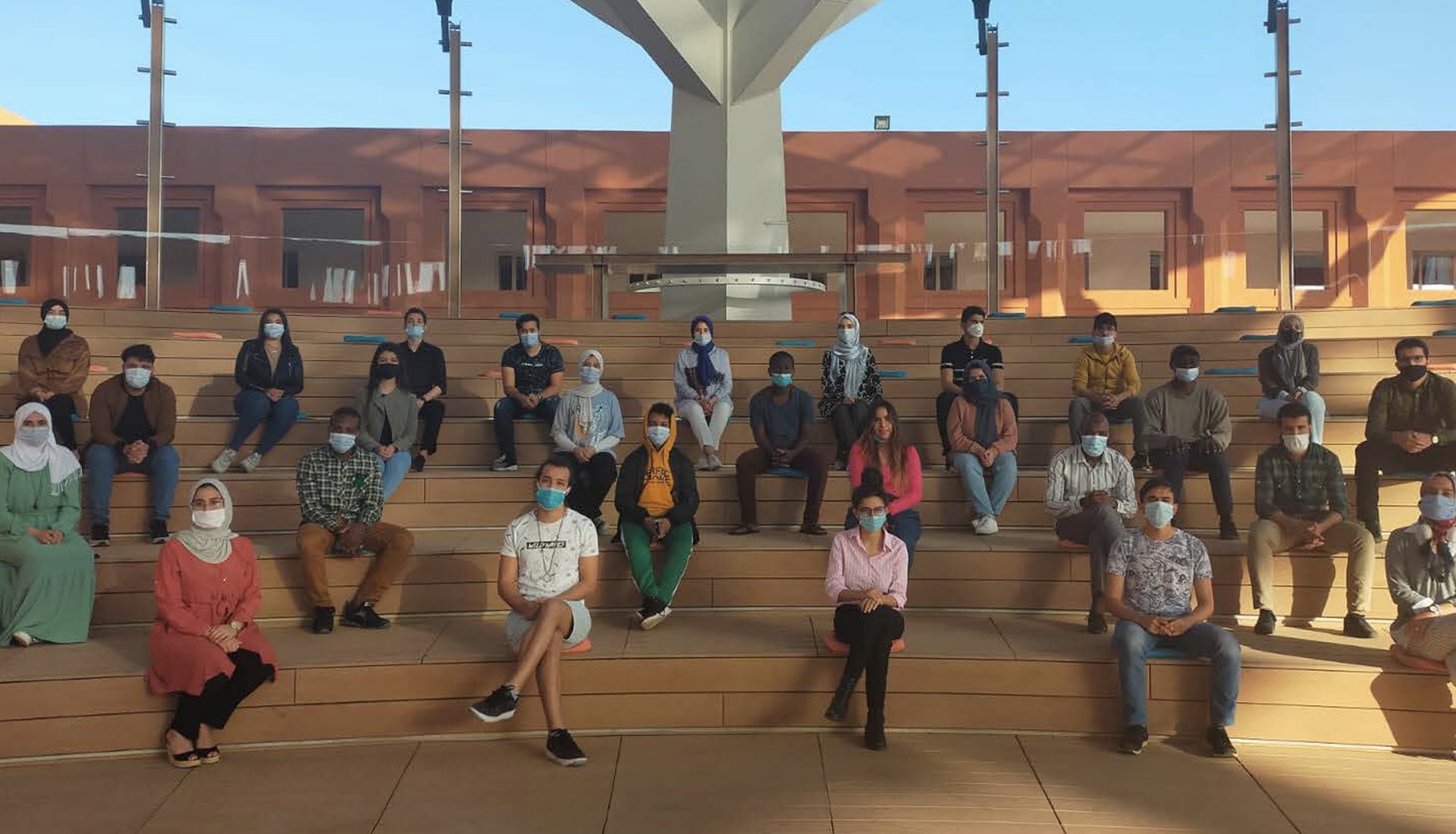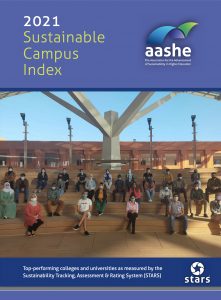The 2021 Sustainable Campus Index (SCI), produced annually by the Association for the Advancement of Sustainability in Higher Education (AASHE), recognizes top-performing colleges and universities overall by institution type and in 17 sustainability impact areas, as measured by the Sustainability Tracking, Assessment & Rating System (STARS), a voluntary framework used by hundreds of colleges and universities to measure, report, and strengthen their contributions to global sustainability.
The SCI also includes innovative and high-impact institutional highlights, and recognizes institutions with exceptional report accuracy and quality.
Following you’ll find a short description of each of the 17 impact areas, along with some of the top institutions that are doing great work as identified by STARS. Note that a complete ranking is included in the full SCI here.
 Air & Climate
Air & Climate
Global climate change brings myriad negative impacts throughout the world, including increased frequency and potency of extreme weather events, sea-level rise, species extinction, water shortages, declining agricultural production, and the spread of diseases. The impacts are particularly pronounced for low-income communities and countries. Institutions that inventory and take steps to reduce their air pollutant emissions can positively impact the health of their local communities and regions. This section covers greenhouse gas emissions assessment and mitigation and outdoor air quality.
- Arizona State University
- Bates College (ME)
- Bowdoin College (ME)
- Colby College (ME)
- Dickinson College (PA)
 Buildings
Buildings
Buildings are generally the largest user of energy and the largest source of greenhouse gas emissions on campuses. Buildings also use significant amounts of potable water. Institutions can design, construct, and maintain buildings in ways that provide a safe, healthy indoor environment for inhabitants, while simultaneously mitigating those buildings’ impact on the outdoor environment. This section covers the maintenance and operations of existing buildings as well as new building design and construction.
- Chatham University (PA)
- Nova Scotia Community College
- University of California Irvine
- University of California Los Angeles
- University of California Merced
 Campus Engagement
Campus Engagement
Engaging in sustainability through cocurricular activities allows students, faculty, and staff to deepen and apply their understandings of sustainability principles. Cocurricular sustainability offerings help to integrate sustainability into the campus culture and encourage behavior changes that promote sustainability. This section covers student and employee sustainability education programs and orientations, assessment of sustainability culture, outreach materials, and campaigns.
- Colby College (ME)
- Colorado State University
- Cornell University (NY)
- Thompson Rivers University (BC)
- University of Connecticut
 Coordination & Planning
Coordination & Planning
Coordination and planning help institutions organize, implement, and publicize sustainability initiatives. These efforts provide the infrastructure to foster sustainability, establish priorities, guide decision making and budgeting, and clarify a vision for a sustainable future. This section covers sustainability planning, coordination, and participatory governance.
- Thompson Rivers University (BC)
- Université de Sherbrooke (QC)
- Université Laval (QC)
- University of Alberta
- University of Georgia
 Curriculum
Curriculum
Higher education institutions are uniquely positioned to understand and address sustainability challenges. Colleges and universities equip students to lead society to a sustainable future by developing and offering learning opportunities in sustainability. This section covers courses, programs, and learning outcomes in sustainability, living laboratory initiatives, immersive experiences, sustainability literacy, and faculty development.
- Colorado State University
- Florida Gulf Coast University
- State University of New York College of Environmental Science and Forestry
- Sterling College (VT)
- University of Connecticut
 Diversity & Affordability
Diversity & Affordability
Higher education opens doors to opportunities that create a more equitable world and must be accessible to all regardless of race, gender, religion, socioeconomic status, and other differences. A diverse body of students, faculty, and staff provide rich resources for learning and collaboration. This section covers diversity coordination, assessment for campus equity, discrimination response, higher education affordability and access, increasing faculty diversity, and support and recruitment of underrepresented students, faculty, and staff.
- Rice University (TX)
- Stanford University (CA)
- Thompson Rivers University (BC)
- University of California Irvine
- University of Texas Rio Grande Valley
 Energy
Energy
For most institutions, energy consumption is the largest source of greenhouse gas emissions. Implementing conservation measures and switching to renewable sources of energy helps institutions save money and protects them from utility rate volatility. Renewable energy may be generated locally and allows campuses to support local economic development. Furthermore, institutions can help shape markets by creating demand for cleaner, renewable sources of energy. This section recognizes energy reduction and development and use of clean, renewable energy sources.
- Bates College (ME)
- Stanford University (CA)
- Thompson Rivers University (BC)
- University of New Hampshire
- University of South Florida Tampa
 Food & Dining
Food & Dining
Institutions can use their food purchases to support local economies, encourage environmentally friendly and humane farming methods, help eliminate unsafe working conditions, and alleviate poverty for farmworkers. These actions reduce environmental impacts, preserve regional farmland, improve local food security, support fair and resilient food systems, and reduce food waste. Dining services support sustainable food systems by making low-impact dining options available and educating customers about more sustainable options. This section covers meatless dining, and sustainable food and beverage purchasing and practices.
- Emory University (GA)
- Sterling College (VT)
- University College Cork – National University of Ireland
- University of Connecticut
- University of Winnipeg (MB)
 Grounds
Grounds
Beautiful and welcoming campus grounds can be planned, planted, and maintained in any region while minimizing the use of toxic chemicals, protecting wildlife habitat, conserving resources, and promoting organic care. This section covers campus land management, sustainable landscaping, and biodiversity of campus grounds and surrounding lands.
- Antioch College (OH)
- Cascadia College (WA)
- Central New Mexico Community College
- Chatham University (PA)
- George Washington University (DC)
 Investment & Finance
Investment & Finance
Collectively, colleges and universities invest hundreds of billions of dollars, and the impacts from investments are both local and global in scope. Using transparent and democratic investment processes improves the long-term health of institutional endowments, encourages better corporate behavior, supports innovative product development, and builds a more just and sustainable financial system. This section covers sustainable investment, committees for responsible investing, and investment disclosure.
- Arizona State University
- Chatham University (PA)
- Hampshire College (MA)
- University College Cork – National University of Ireland
- Warren Wilson College (NC)
 Public Engagement
Public Engagement
Engagement in problem-solving with community members and organizations in the governmental, nonprofit, and for-profit sectors encourages widespread solutions to sustainability challenges. Public engagement helps students develop leadership skills while deepening their understandings of practical, real-world problems and the process of creating solutions. This section covers community and intercampus partnerships, continuing education, community service, public policy participation, and trademark licensing.
- Colorado State University
- Cornell University (NY)
- Indiana University-Purdue University Indianapolis
- State University of New York College of Environmental Science and Forestry
- University of Connecticut
 Purchasing
Purchasing
Collectively, institutions spend many billions of dollars on goods and services annually. Each purchasing decision represents an opportunity for institutions to choose environmentally and socially preferable products and services and support companies with strong commitments to sustainability. This section covers general and commodity-specific sustainable purchasing policies, life-cycle cost analysis, and purchase of electronics, paper, and cleaning products.
- Dalhousie University (NS)
- Keene State College (NH)
- McGill University (QC)
- University of Dayton (OH)
- University of Ontario Institute of Technology
 Research
Research
By researching sustainability issues and refining theories and concepts, higher education institutions help the world to understand sustainability challenges and develop new technologies, strategies, and approaches to address those challenges. This section covers faculty and department sustainability research and initiatives for open-access research.
- Binghamton University (NY)
- Florida State University
- Keene State College (NH)
- University of California Irvine
- University of California Merced
 Transportation
Transportation
Institutions positively impact human and ecological health and support local economies by modeling sustainable transportation systems. Transportation-related emissions and pollutants contribute to health problems which, due to disproportionate exposure, are more pronounced in low-income communities near major transportation corridors. In addition, fuel extraction, production, and distribution damages environmentally and culturally significant ecosystems and financially benefits oppressive governments. This section covers campus fleets, student/employee modal split, and programs promoting sustainable transportation.
- California State University San Bernardino
- Columbia University (NY)
- Dawson College (QC)
- Ryerson University (ON)
- University of Washington Seattle
 Waste
Waste
Waste reduction mitigates the need to extract virgin materials from the earth and reduces waste flow to incinerators and landfills that contaminate air and water, produce greenhouse gas emissions, and result in disproportionate negative impacts on low-income communities. Source reduction and waste diversion also save institutions costly landfill and hauling costs. Campaigns for waste reduction engage the entire campus community in contributing to tangible sustainability goals. This section recognizes waste minimization and reduction construction, waste diversion, and hazardous waste management.
- Aquinas College (MI)
- Nova Scotia Community College
- Thompson Rivers University (BC)
- Université de Sherbrooke (QC)
- University of Texas at San Antonio
 Water
Water
Water conservation and reuse, as well as effective rainwater management practices, maintain and protect finite groundwater supplies. Pumping, delivering, and treating water is also a major driver of energy consumption. Institutions reduce energy usage and the emissions associated with energy generation by conserving water. Water conservation and effective rainwater and wastewater management diminish the need for effluent discharge into local surface water supplies, which consequently improves the health of local water ecosystems. This section covers water use reduction and rainwater management.
- American University (DC)
- Colorado College
- San Francisco State University (CA)
- University of Connecticut
- University of Maryland Baltimore County
 Wellbeing & Work
Wellbeing & Work
An organization’s character, capacity to perform, and achievements are only as strong as that organization’s community. Colleges and universities bolster the strength of their communities by promoting the wellbeing of the campus community and by offering worker benefits, wages, and other forms of assistance that serve to compensate workers respectfully and ethically. This section recognizes student and employee wellness programs and employee compensation, satisfaction, health, and safety.
- Stanford University (CA)
- Université Laval (QC)
- University of California Berkeley
- University of California Los Angeles
- University of Massachusetts Lowell
The wide array of impact areas covered through STARS and the Sustainable Campus Index embraces the premise that every institution has a unique approach to addressing sustainability challenges and can find its own path toward sustainability excellence. Top performers are determined based on STARS scoring data from the 375 institutions that submitted STARS reports in the prior three years.
In total, 131 higher education institutions were recognized as Top Performers in at least one category, including six institutions that submitted their first STARS report in the 2020-21 reporting year. The top performer lists and highlighted best practices included throughout this publication aim to inspire students, administrators, faculty, staff, and partners of colleges and universities to work together to implement innovative solutions to sustainability challenges.
Monika Urbanski is AASHE’s senior manager of resources and data quality and can be reached at [email protected]. Excerpted with permission from the 2021 Sustainable Campus Index, Association for the Advancement of Sustainability in Higher Education (AASHE). Thanks to Julian Dautremont, AASHE’s director of programs, for his assistance with this article.




